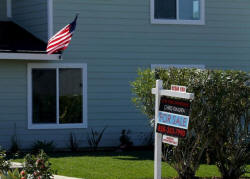U.S. home sales sag as prices race to record high
 Send a link to a friend
Send a link to a friend
 [July 24, 2018]
By Lucia Mutikani [July 24, 2018]
By Lucia Mutikani
WASHINGTON (Reuters) - U.S. home sales
unexpectedly fell in June, posting their third straight monthly decline
as a persistent shortage of properties on the market drove house prices
to a record high.
The report on Monday from the National Association of Realtors (NAR)
added to last week's soft homebuilding data in suggesting that the
housing market lagged an apparent acceleration in economic growth in the
second quarter.
While supply constraints have accounted for the weak sales streak, there
are growing concerns that the higher house prices and rising mortgage
rates will cause demand to slow.
"The overall economy is in great shape, but there are a few cracks in
the armor," said Joel Naroff, chief economist at Naroff Economic
Advisors in Holland, Pennsylvania. "The key housing market is suffering
from a major case of agita."
Existing home sales slipped 0.6 percent to a seasonally adjusted annual
rate of 5.38 million units last month, the NAR said. May's sales pace
was revised down to 5.41 million units from the previously reported 5.43
million units.

Economists polled by Reuters had forecast existing home sales gaining
0.5 percent in June. Sales rose in the Northeast and Midwest. They fell
in the West, which has seen a sharp rise in prices, and the South, where
most of the homes are sold.
Existing home sales, which make up about 90 percent of U.S. home sales,
dropped 2.2 percent from a year ago in June. They have declined on a
year-over-year basis for four consecutive months and decreased 2.2
percent in the first half of 2018.
Sales are being stymied by an acute shortages of homes on the market.
Rising building materials costs as well as shortages of land and labor
have left builders unable to bridge the inventory gap, pushing up house
prices.
The median house price increased 5.2 percent from a year ago to an
all-time high of $276,900 in June. That was the 76th consecutive month
of year-on-year price gains.
The 30-year mortgage rate is around 4.52 percent, according to data from
mortgage finance agency Freddie Mac. In contrast, annual wage growth has
been stuck below 3 percent.
The PHLX housing index <.HGX> declined, underperforming a broadly flat
stock market. Prices for U.S. Treasuries were trading lower, while the
dollar rose against a basket of currencies.
[to top of second column] |

A "For Sale" sign is seen outside a home in Cardiff, California
February 22, 2016. REUTERS/Mike Blake/File Photo

TRAILING OVERALL ECONOMY
June's weak sales suggested a marginal gain in brokers' commissions in the
second quarter. Economists expect little or no contribution from housing to
second-quarter gross domestic product.
Growth estimates for the April-June period are as high as a 5.2 percent
annualized pace. The economy grew at a 2.0 percent rate in the first quarter,
with residential investment contracting. The government will publish its
snapshot of second-quarter GDP growth on Friday.
"Residential construction won't add much to second-quarter GDP growth," said Sal
Guatieri, a senior economist at BMO Capital Markets in Toronto. "Thankfully,
there are still plenty of other cylinders - consumers, businesses and exporters
- to fuel this economy amid turbo-charged fiscal policies."
Housing supply is especially tight at the lower end of the market, with sales
dropping 18 percent in June from a year ago.
There were 1.95 million previously owned homes on the market in June, up 0.5
percent from a year ago. That was the first year-on-year increase since June
2015, but supply remains very tight. At June's sales pace, it would take 4.3
months to exhaust the current inventory, up from 4.1 months in May.
A six-to-seven-month supply is viewed as a healthy balance between supply and
demand. While last month's increase in the stock of houses on the market
suggested that the inventory decline had probably run its course, the supply
crunch is unlikely to ease soon.
The Commerce Department reported last week that housing starts tumbled 12.3
percent to a rate of 1.173 million units in June, the lowest level in nine
months, and well below the 1.5 million to 1.6 million units per month range that
realtors estimate is needed to alleviate the shortage.
Houses for sale typically stayed on the market for 26 days in June, unchanged
from the last three months and down from 28 days a year ago. Fifty-eight percent
of homes sold in June were on the market for less than a month. The share of
first-time buyers was unchanged at 31 percent last month.
(Reporting by Lucia Mutikani; Editing by Andrea Ricci)
[© 2018 Thomson Reuters. All rights
reserved.] Copyright 2018 Reuters. All rights reserved. This material may not be published,
broadcast, rewritten or redistributed.
Thompson Reuters is solely responsible for this content. |